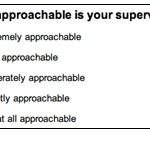Words speak louder than numbers.
Imagine this: You go furniture shopping with your friend Angela. “So,” Angela says, “what do you think of this lamp?” You shrug and reply, “2.”
Okay, let’s be honest, the above scenario is unlikely. First of all, you know better than to go shopping with Angela–she has terrible taste and is incredibly indecisive. Secondly, very few people actually answer opinion questions with numbers in real life. The only time we really do that is on questionnaires.
A questionnaire can be thought of as a conversation between the person asking the questions and the person answering them. We don’t talk in numbers, and we shouldn’t survey with them either. But coming up with a range of word labels to go along with the numbered responses on a survey question can be tricky.
For example, take the following question…

If you give someone a survey with the question to the right, odds are they’re not going to have a clue what you’re really asking, or how to respond. The answer will be more reliable for you, and less stressful for your respondent, if you include some descriptive words along with numbers.
The easiest place to start labeling your options is at the endpoints. Our question is about approachability, so a good label for “5” is “extremely approachable,” and a good label for “1” is “not at all approachable.” This is just one option; the important thing is that the endpoints are the extremes of your scale–there should be no higher/bigger/stronger description than what you use for 5, and no lower/smaller/weaker description than what you use for 1.
So now that leaves us just 2, 3, and 4 to label. The midpoint of the scale (in this case “3”) should be just that, a midpoint. It’s best to have it represent moderation, rather than neutrality or ambivalence. “2” and “4” should be a bit less and a bit more, respectively, than the midpoint—but less than the extremes.
Usually, if you have a 5-point scale (like we have here) the easiest fix is the following:
4 = “very <insert adjective here>”
3 = “moderately <insert adjective here>”
2 = “slightly <insert adjective here>”
Unfortunately, these labels don’t always fit, so sometimes you’ll have to use your creativity. (Or use our Question Bank feature and let us do the heavy-lifting for you!) One more word of warning: Whatever adjective you use in your answer choices, (in our example the adjective is “approachable”) try to keep it consistent so people taking your questionnaire don’t get confused.
So, using these rules, this is the correct way to ask the question…

This format ensures that the people answering your survey know exactly what you’re asking. Even better, it helps you to make sense of the responses that you get back. An average response of “2” suddenly translates into the easily understandable label of “slightly approachable.” This can be a huge help if you’re using questions to generate performance feedback for colleagues.
Letting someone know in a performance review that they’re a 2 in approachability might not hit home. Telling someone that people think they’re only “slightly approachable” is more likely to make an impact.
Stumped on how to label the numbered answer choices to your particular question? Let us know in the comments section below!




